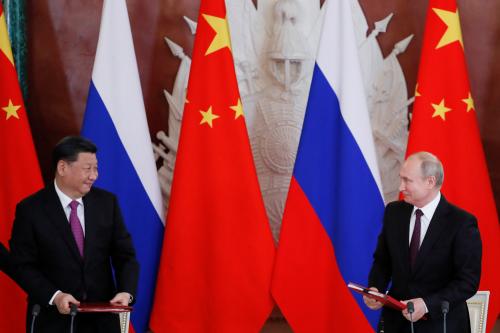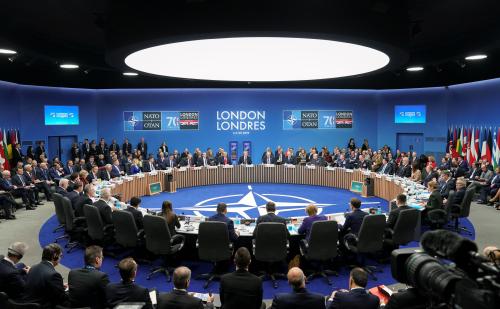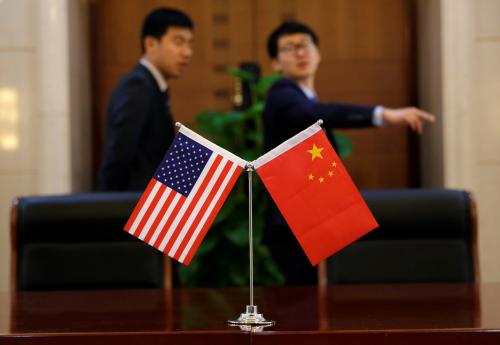The Vitals
The United States’ relationship with Russia is today the worst that it has been since 1985. Moscow’s interference in the 2016 U.S. presidential election and what appears to be its continuing attempts to affect the 2020 election campaign have made Russia a toxic domestic issue in a way that it has not been since the 1950s. Its annexation of Crimea and launch of an ongoing war in southeastern Ukraine, plus its support for Syria’s Bashar al-Assad in his brutal civil war, and for Venezuela’s Nicolas Maduro have raised tensions with the United States. President Trump came into office determined to improve ties with Russia. But the rest of the executive branch and the U.S. Congress have pursued tough policies toward Russia, imposing rafts of sanctions and expelling diplomats. The U.S. National Security Strategy declares Russia and China the two top threats to U.S. national security. At the best of times, U.S.-Russia ties are a mixture of cooperation and competition, but today they are largely adversarial.
Yet, as the world’s two nuclear superpowers, Russia and the United States bear a unique responsibility to keep the peace and discourage the proliferation of nuclear, biological, and chemical weapons around the globe. Moreover, there are global challenges such as terrorism, climate change, governing the Arctic, and dealing with the COVID-19 pandemic that necessitate working together. The challenge is to find an acceptable balance between cooperation and competition and to compartmentalize the relationship in a more effective way than at present.
-
The United States’ relationship with Russia is today the worst that it has been since 1985.
-
Under Putin, Russia has become a centralized, authoritarian state and has returned as a global player, competing with the United States for influence.
-
Today’s global challenges require Russia and the United States to find the right balance between cooperation and competition.
A closer look
How did we get to where we are today?
After the USSR collapsed, many in the United States assumed that once the Russians had thrown off the shackles of Soviet communism they would want to join the West and become more like Americans and Europeans. The U.S sent political and economic advisers to work with officials and people in the nascent private sector to promote democracy and markets. But it turned out that centuries of Russian and Soviet history had produced a unique and distinct understanding of Russia’s place in the world and the form of government it should have. The 1990s, during which Russia was a more pluralist society than it is today, is now remembered as a time of chaos, enriching a few and impoverishing many, during which Russia was “humiliated” by having to accept an agenda largely dictated by the United States. Russia’s legitimate interests, so this narrative goes, were ignored by the United States. This includes Russia’s right to a sphere of influence in the post-Soviet states, meaning that they should not aspire to join NATO or the European Union. Today, Russia defines its security perimeter not as the borders of the Russian Federation, but as the borders of the former Soviet Union. It demands that the United States and Europe acknowledge this. So far, Washington has refused to accept that premise and insists on Russia’s neighbors’ right to choose their foreign policy orientation.
Under President Vladimir Putin, Russia has become a centralized, authoritarian state and has returned as a global player, competing with the United States for influence. Although it is weaker than the U.S. both economically and military, it has the ability to intervene around the globe and to thwart U.S. interests. Washington and Moscow have fundamentally different ideas about what a productive relationship would look like.
There have been two periods in recent history when cooperation between the U.S. and Russia has worked well: the immediate post-9/11 period when Russia assisted the United States in the first phase of the war in Afghanistan, providing information which it had collected from its decade-long war there; and during the 2008-12 period of the “reset” between Presidents Barack Obama and Dmitry Medvedev, when Moscow and Washington cooperated on arms control, Afghanistan, Iran, and a range of other issues.
Relations began to sour when Putin returned to the Kremlin in 2012, convinced that Hillary Clinton had been behind the demonstrators who had protested his return to power. The next year, Putin granted political asylum to Edward Snowden, the disgruntled NSA contractor who stole millions of classified documents and fled to Russia via Hong Kong. It rebuffed President Obama’s request to return him. Obama then canceled a planned summit with Putin.
Russia’s actions in 2014 dealt another major blow to the relationship. Following months of popular protests, the pro-Russia Ukrainian President Viktor Yanukovych fled to Russia and was replaced by a pro-Western government. Shortly thereafter, Russian troops moved in to occupy and annex the Crimean Peninsula, which had been part of Ukraine since 1954, thereby violating the terms of the 1994 Budapest Memorandum in which Russia, the United States, Ukraine, and the United Kingdom had pledged to uphold Ukraine’s territorial integrity. During the next few months, Russian-backed separatists and Russian troops wearing no insignia moved in to occupy the parts of the Donbas region in southeastern Ukraine, ousting the legitimate local authorities. Since the spring of 2014, Russia and Ukraine have been fighting a war in the Donbas region in which 14,000 have died. Responding to this violation of sovereignty, the United States imposed sanctions on Russian individuals close to Putin and on Russia’s ability to access financial markets.
Russia’s entry into the Syrian civil war in 2015 to support Bashar al-Assad has also created tensions with the United States, which was supporting groups opposed to Assad. Since then, Washington and Moscow have had to deconflict their air operations in Syria to prevent unanticipated collisions. After the U.S.’s partial withdrawal from Syria, Russian troops occupied former U.S. bases and supported Assad’s brutal assault on Idlib Province, which has produced a million refugees.
The decisive major blow to U.S-Russia relations was Russia’s cyber interference in the 2016 U.S. presidential election campaign. As detailed in the 2019 Mueller Report, a troll factory in St. Petersburg worked round the clock to use social media to exacerbate the political polarization that existed in U.S. society, cast doubt among Americans about the legitimacy of the own democracy, and use these platforms to favor Donald Trump over Hillary Clinton. Russia also tried to penetrate election machines in some states, raising the possibility that it could seek to change the outcome of future elections. The election interference via social media has continued into the 2020 electoral cycle.
What are the most pressing issues for the next administration to tackle?
The most immediate issue is the fate of the New START Treaty on strategic offensive weapons, set to expire on February 5, 2021. This is the latest iteration of the SALT (Strategic Arms Limitation Talks) Treaty signed by President Richard Nixon in Moscow in 1972. These treaties have for 50 years set limits on the numbers of warheads and delivery vehicles each side can have and they allow for on-site verification to ensure compliance. New START could be extended for another 5 years as-is while the two sides negotiate about what a future treaty that takes into account the modernization of nuclear weapons and the growth of cyber capabilities should involve. The Trump administration has insisted that any new treaty include China’s nuclear arsenal, but Beijing has demurred, arguing that its nuclear arsenal is far smaller than that of either the United States or Russia who between them possess 90% of the world’s nuclear weaponry. Both the U.S. and Russia have pulled out of the 1987 Intermediate-Range Nuclear Forces Treaty, so that the only remaining piece of the arms control structure is New START. If this is not extended, then by 2021 there will be nothing limiting the nuclear arsenals of the U.S. and Russia, with serious implications both for the proliferation of nuclear weapons and for a costly future arms race.
Resolving the conflict in Ukraine will remain a very difficult. Although the United States is not included in the “Normandy Format”—Germany, France, Russia, and Ukraine—that seeks to end the war, it still has an important role to play in negotiations for peace and in supporting Ukraine. It needs to resume a more active role.
Russia’s increasingly close relationship with China represents an ongoing challenge for the United States. While there is little that Washington can do to draw Moscow away from Beijing, it should not pursue policies that drive the two countries closer together, such as the trade war with China and rafts of sanctions against Russia.
The sanctions against Russia have impacted Russia’s economy adversely, but they have not led Russia either to moderate its actions in Ukraine or to diminish its cyber interference inside the United States. Moreover, the sanctions such as those on the Nord Stream 2 gas pipeline from Russia to Germany have adversely impacted U.S. allies but have had only a limited impact on Russia itself. The pipeline is delayed, but it will almost certainly be completed. Congressionally-imposed sanctions are a blunt punitive instrument carrying few incentives to induce Russia to rethink its policies. They should be re-examined in terms of their effectiveness as a tool for affecting Russian behavior.
The COVID-19 pandemic may represent an opportunity for the United States to re-engage Russia by cooperating in battling the disease. But developing a more productive relationship with Russia will remain a major challenge for the United States. Washington and Moscow have different understandings of the drivers of world politics. Russia seeks to create a “post-West” world in which the United States is one of several great power players and can no longer dominate the international scene. It seeks U.S. recognition for its right to a sphere of influence. So far, no U.S. administration since the Soviet collapse has been willing to accept this premise.







Commentary
Why are US-Russia relations so challenging?
April 27, 2020